The Rubin Museum of Art is a vertically structured museum that displays Tibetan art, which comes from several regions in Eurasia. Overall, all of the art visually did seem really detailed and cool, but it was difficult to find a message in each one. Here are some interesting pieces that I found:
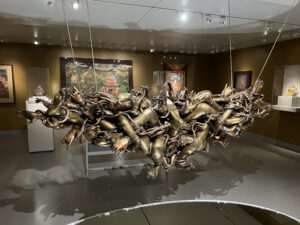

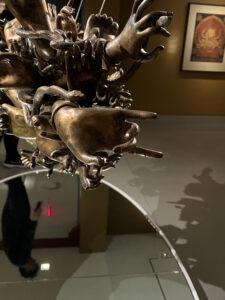

1. “Muted Expressions” – 2022
When I looked at this piece of art, I thought of chaos. There were so many hands and legs all scrambled together, and too much to look at all at once. Then this lady who worked at the museum came up to my friends and I, and told us about the context of this piece, as well as tiny details about it. She said that the artist created this piece in response to the devastating earthquakes that took place in Nepal in 2015, and pointed out the “peace” and “rock on” signs gestured by some of the hands, as well as the shadow above. The hand gestures give you that feeling that people similar to you were unfortunately affected by this disaster, and the shadow gives that feeling that the hands of the people were trapped within the earthquake and couldn’t escape.
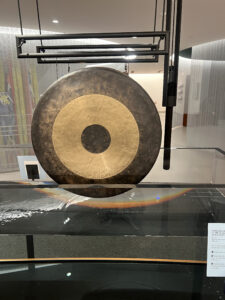
2. The Gong Exhibit
I have been playing instruments for a really long time, so an exhibit that involves making and listening to a sound caught my attention. There were 8 gongs, 4 on each side, hanging above water, with a stick corresponding to each one. The exhibits told you first to imagine your anger, then gently strike the gong, raise the handle that was located to the left of it to slowly drop it into the water, and then listen to the sound of your anger transform. I wasn’t in the mood to imagine my anger, so I just listened to the sound they made. I feel like most of the gongs were disappointing as they were too quiet when gently striking it and I usually would think that anger would sound loud. However, the gong in the picture above was strikingly loud compared to the other ones, and when sinking it into the water, I was able to hear the sound waves frequency change and pitch drop. I think it was the best example out of all the gongs to show water absorbing the anger created by the strike.
3. The Smell Exhibit
I didn’t take any pictures of this exhibit, but basically it was 6 stations that each had a touchscreen and a red button. Pressing the red button would dispense the scent corresponding to it, and the screen would prompt you to respond with an emotion you felt after smelling it. I found it very difficult to recall an emotional response to them, but there was one smell that I was curious about. It was the smell of rice fields according to the author, but for me it reminded me of a grandparents house. I thought this was a great example that people can retrieve different responses to art unintended by the artist.
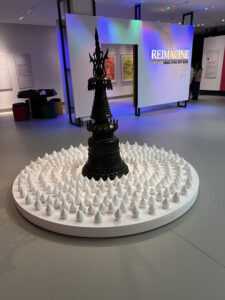
4. “Field of Wishes” – 2023, by Sonam Dolma Brauen
This piece contains a bunch of clay molds called tsatsas surrounding a larger structure. In the Tibetan Buddhist tradition, people mixed the ashes of the deceased with clay molds and created figurines using it. They would then place these figurines in sacred places. When I first saw this art piece, I didn’t know what was trying to be conveyed, but it did seem like each tsatsa contained different meanings because of the large repetition of them. There was a video near it that showed how this specific installation in this museum was created. The shape was acquired by the tsatsa mold the artist’s family brought with them when escaping Tibet. She also hosted a workshop and invited people to create the tsatsas, as well as inserting a piece of paper into them that says their wish. The text associated with this art piece says the artist’s intent is to convey “peace, togetherness, and connection to one another.”
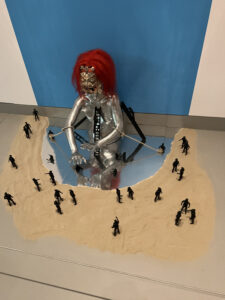
5. “The Protectors” – 2024, Jupiter Pradhan
I wouldn’t have written about this art piece if it wasn’t for the same lady I mentioned when I wrote about the “Muted Expressions” art piece. When I first took a glimpse of it, I thought the large sculpture represented evil, since that’s how we perceive the color red as in today’s world. However, the lady told us that this sculpture is supposed to be a hero, and the figurines around it are being protected by it. The sculpture represents “Mahakala”, the god of time, creation, destruction, and power. I went back to see the artpiece and saw that the soldier toys seemed to be comfortable and were helping the larger sculpture.
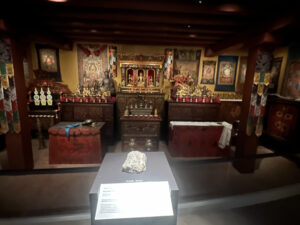
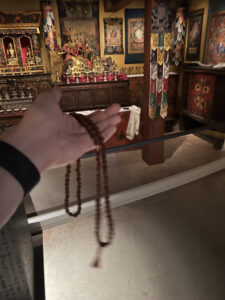
6. “The Tibetan Buddhist Shrine Room”
This was the largest exhibition in The Rubin. It displayed what a private household shrine looked like, where people would practice religion. In this room I noticed some similarities to the Catholic Church I attend every Sunday. The chalice in the middle looked similar to the one used at the Church I attend, and there were prayer beads on the side of the wall that anyone was able to grab, which people also use in Catholicism. This conveyed to me that no matter how different we seem to be, we are connected in some sort of way.
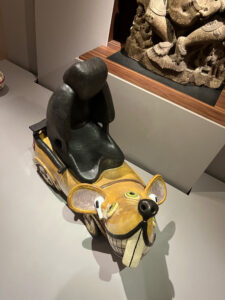
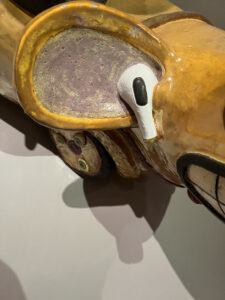
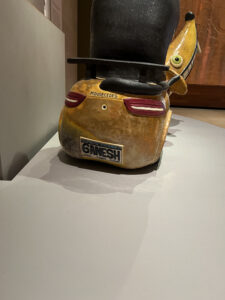
7. “Uber Rat” – 2023, Shushank Shrestha
What instantly caught my attention when seeing this art was the airpod pros. Airpod pros were released in 2019 and are a big part of New York culture, which instantly made me realize that the sculpture was recently made and related to people like me. The artist mixed New York culture with a divine being, and I like the “hidden easter eggs” on it, like how the car brand was called “mouscedes”.
Although I was able to receive a meaning from several different art pieces at this museum, most of them seemed like they required context to understand. On top of that, most of the art pieces I did get a meaning from also required context. That said, I did enjoy the time I spent there with my friends, but I probably wouldn’t go there again, since I am not really interested in Tibetan art.


